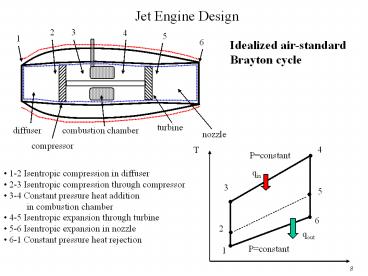Jet Engine Design - PowerPoint PPT Presentation
1 / 8
Title:
Jet Engine Design
Description:
Jet Engine Design 2 3 4 5 1 6 Idealized air-standard Brayton cycle turbine diffuser combustion chamber nozzle compressor 4 T P=constant qin 1-2 Isentropic compression ... – PowerPoint PPT presentation
Number of Views:145
Avg rating:3.0/5.0
Title: Jet Engine Design
1
Jet Engine Design
2
3
4
5
1
6
Idealized air-standard Brayton cycle
turbine
diffuser
combustion chamber
nozzle
compressor
- 1-2 Isentropic compression in diffuser
- 2-3 Isentropic compression through compressor
- 3-4 Constant pressure heat addition
- in combustion chamber
- 4-5 Isentropic expansion through turbine
- 5-6 Isentropic expansion in nozzle
- 6-1 Constant pressure heat rejection
2
Problem Statement
- A jet aircraft moves with a velocity of 200 m/s
where the air temperature is 20C and the
pressure is 101 kPa. The inlet and exit areas of
the turbojet engine of the aircraft are 1 m2 and
0.6 m2, respectively. It is known that the exit
jet nozzle velocity is 1522 m/s (from lab
calculation) if the exhaust gases expand to 101
kPa at a temperature of 1,000C. The mass flow
rates of the inlet and exhaust flow are 240 kg/s
and 252 kg/s, respectively. As a thermal
engineer, your task is to (a) determine if the
temperature of the exhaust gases is too high for
the turbine blades as they exit from the
combustion chamber. (b) Determine the amount of
combustion energy necessary to provide the
thrust. The maximum tolerable temperature of the
blades is 3,000 K. It is known that the pressure
ratio of the multi-stage compressor is 8 to 1. - Assumptions and simplifications
- neglect all losses and irreversibilities. All
processes are isentropic. - Neglect all kinetic energy components except at
the inlet and the nozzle. - Air and fuel mixture behaves as an ideal gas and
has the same thermal properties as the air. - All shaft works produced by the turbine are used
to drive the compressor. - Air ( mixture) has a constant CP1 kJ/kg.K, and
k1.4
3
Procedures
- Between sections 1 and 2, the incoming flow
slows down to increase both the pressure and the
temperature before it enters the compressor
section. It is an isentropic process.
- Across the compressor, the pressure is further
increase to eight times of P2 and this is
accompanied by an increase of temperature also.
P38P21018.4(kPa)
4
Procedures (cont.)
- The shaft work of the compressor is equal to the
difference of enthalpy before and after the
compressor.
- The same amount of shaft work is produced across
the turbine section as assumed.
- In order to determine the temperature entering
the turbine (T4), we need to find the temperature
exiting the turbine (T5) and it is related to the
temperature exiting the nozzle (T6) as it is
expanding in the nozzle through an isentropic
process.
5
Procedures (cont.)
- Therefore, the temperature of the hot gas
entering the turbine section will be at a
temperature of T4T5242.22673.2(K) and it is
below the maximum tolerable temperature of 3,000
K. - The total thermal energy supplied into the
engine can be determined as the difference of the
energy in and out of the combustion chamber
- Note I neglect the energy of the fuel by
assuming that is small compared to the combustion
energy.
6
Propulsion Efficiency
Define propulsion efficiency as the ratio of the
thrust power (PT) to the rate of production of
propellant kinetic energy (PTPL). Where the
total kinetic energy is the sum of the thrust
power and the power that is lost to the exhaust
jet (PL).
7
Propulsion Efficiency Turbofan
- The propulsion efficiency increases as the
velocity ratio is increased. - It reaches a maximum at v1 and h1. No lost
kinetic energy but also no thrust since V1V6. - It also suggests that in order to increase the
propulsion efficiency one would like to operate
at relatively low jet nozzle velocity. - In order to avoid the loss of thrust, the mass
flow rate has to be increased.
- Consequently, turbofan engine is a more
efficiency engine as compared to the turbojet
engine since the fan can induce large amount of
the propellant into the engine and can operate at
a relatively low jet exhaust speed.
8
Gas Power Cycle - Jet Propulsion Technology, A
Case Study
Pratt_Whitney Turbojet Engine
Pratt-Whitney Turbofan Engine































